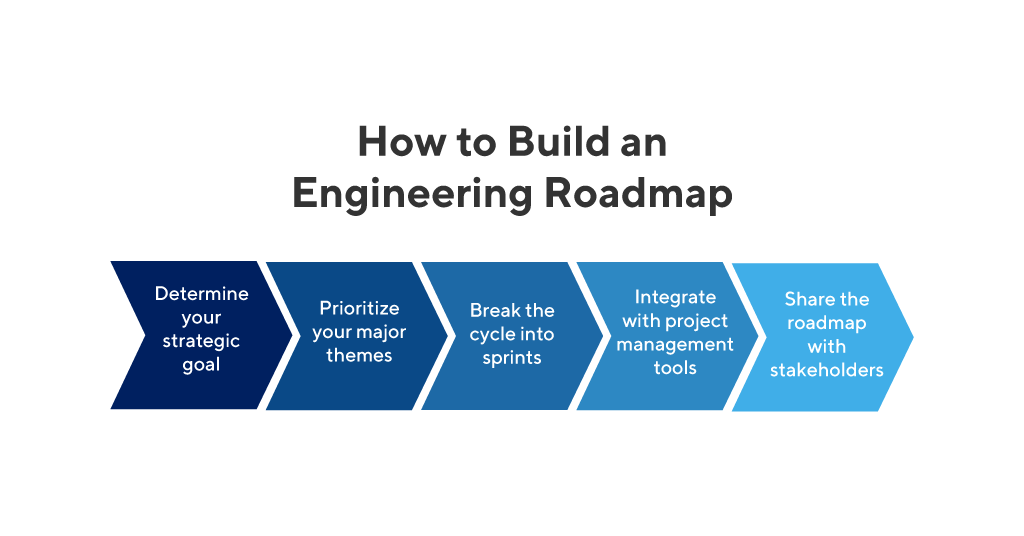What is an Engineering Roadmap?
An engineering roadmap is a high-level overview of the plans and objectives for developing a product.
An engineering roadmap for a business that makes computers, for example, would summarize major goals and milestones of the designers and component engineers who develop the company’s products. At a software maker, it would summarize the work of the developers responsible for coding the company’s apps. An engineering roadmap in a software company could also be called a software development roadmap.
Note: An engineering roadmap is not the same as an IT roadmap or an infrastructure roadmap. Those roadmaps are internal, focused on the strategic plans and goals for a company’s technology infrastructure. An engineering roadmap focuses on the plans for building the products that the company plans to sell.
Engineering roadmaps can be helpful in any company that develops physical or digital products. Still, agile development organizations most often use them.
When do Product Engineering Teams need a Roadmap?
Having a roadmap that summarizes their department’s high-level plans and goals can help an engineering team in several ways.
For example:
- It helps the company’s engineers understand the bigger strategic picture. When engineers in an agile organization begin a sprint, their focus becomes narrow. They have specific user stories, bug fixes, or other tactical work to complete within a few weeks. With an engineering roadmap, these engineers can step back at any time and see how the small jobs they are working on today fit into the company’s bigger plans for success. The roadmap can both help these engineers stay focused and inspire them to work through what might seem like unimportant daily tasks.
- It leads to better engineering decisions. Engineering teams have to make many decisions, often in a hurry, throughout the product development process. A high-level roadmap, reminding them of the strategic vision, can help with these decisions. Having the roadmap to refer to will enable engineers to intelligently answer the many questions that come up from day-to-day. Then they can make better decisions when faced with choices about how to handle their tasks.
- It helps keep the team on time and on budget. If an engineering department were to plan its resources only one sprint at a time, the team would likely face capacity and budget problems over time. The engineering department will be ill-prepared for what was coming next. For example, if the current sprint was only lightly taxing the team’s engineers but the upcoming sprint was going to be extremely demanding, then they’ll have problems. An engineering roadmap can solve these problems. It allows the team to take a longer-term view, and plan resources accordingly.
How to Build Your Engineering Roadmap
If you’ve never created an engineering roadmap, starting from scratch might feel overwhelming. So here is a step-by-step checklist to help get you started.

STEP 1:
Determine your big-picture strategic goal.
With any roadmap, you need to start with the end in mind. Answer the following questions and you’re off to a good start.
- Why are you creating this roadmap?
- What high-level strategic goal do you want your engineering team to accomplish?
- What will success look like?
STEP 2: Prioritize the significant themes (or epics) of your engineering plan.
Now that you have a strategic vision for your engineering roadmap, it’s time to translate that vision into specific goals for your engineering team to tackle. On a roadmap, these high-level goals are called themes or epics.
STEP 3: Break your long-term plan into short sprints.
Agile organizations break development cycles into sprints. These are short periods of engineering work (usually two weeks or one month), where the team completes only a few agreed-upon pieces of work. Break your engineering roadmap into several sprints—for example, a half-dozen one-month sprints across a six-month roadmap. Your roadmap’s epics and themes will often include work that spans several sprints.
STEP 4: Set up teams and their areas of responsibility.
At this point, you’ve broken down the planned work to the individual sprint level. Now it’s time to establish teams and decide who’s going to be working on what. As you’ll see in the engineering roadmap template below, you can break your roadmap’s lanes into engineering teams. With lanes, each team and engineer can easily see what they’ll be working on throughout the cycle.
STEP 5: Integrate the roadmap with your project management tools.
Your engineering roadmap should represent only the high-level plans and initiatives for your team. In order to assign and monitor the day-to-day tasks your engineers will be working on, you’ll want to use your favorite project-management application. With the right roadmap software, you can integrate your roadmap’s initiatives with your project-management tool, so that you can keep both your detailed to-do lists and your high-level overview up to date. For example, ProductPlan’s roadmap software integrates with Jira as well as with Pivotal Tracker.
STEP 6: Share your roadmap with relevant stakeholders.
After you’ve populated your engineering roadmap with epics and themes, sprints, teams, milestones your final action will be to share it with stakeholders. You will want to show your big-picture plans for product development (including engineering) work over the coming months or years. Other interested stakeholders could consist of your executive staff, who might want to see your plan for completing a large-scale engineering initiative. In the section below, you’ll find a few best practices for sharing your engineering roadmap.
STEP 7: Stay flexible because things change.
It’s important to understand that your engineering roadmap is only a guide and not a set-in-stone plan that you must closely adhere to. During such an extended period, things can change. You might lose resources to a higher-priority project in the company or engineer with a key skillset you can’t easily replace. An executive might demand your team to shorten its development timeframe. So stay flexible, refer back to your roadmap regularly, and be ready to shift things around if necessary.
Tips for Sharing Your Completed Engineering Roadmap
Start with why.
Simon Sinek popularized the term “Start with Why” first in his famous TED Talk and then in the book by the same name. The concept refers to giving your audience a reason to get behind your product or project before rattling off a list of its features or other details.
When you present your roadmap to stakeholders, open the discussion by explaining why you’ve developed the plan you’re about to share. The details won’t matter to your audience until they understand how you envision the project helps the business.
Make it visual.
Your engineering roadmap presentation will be a lot more compelling if your audience can quickly and easily grasp your high-level goals and plans. The best way to achieve this clarity in the room is by using a visual roadmap—not a spreadsheet or document that lists the details.
Be concise.
You should be able to communicate the critical points behind your plan in everyday language, using just a sentence or two. For example: “Our evidence suggests developing mobile versions of these two products will help us break into these three markets…” or “… could help us increase our overall user base by 15% by the end of the year.”
Be ready with data.
Your roadmap presentation doesn’t have to include all of the market research, usage data, and other evidence you analyzed to make your decisions about what to build and when. Doing so will only clutter your presentation and confuse your stakeholders. But you will want to have this critical data handy, in case people in your audience ask for evidence supporting your plans or claims.



